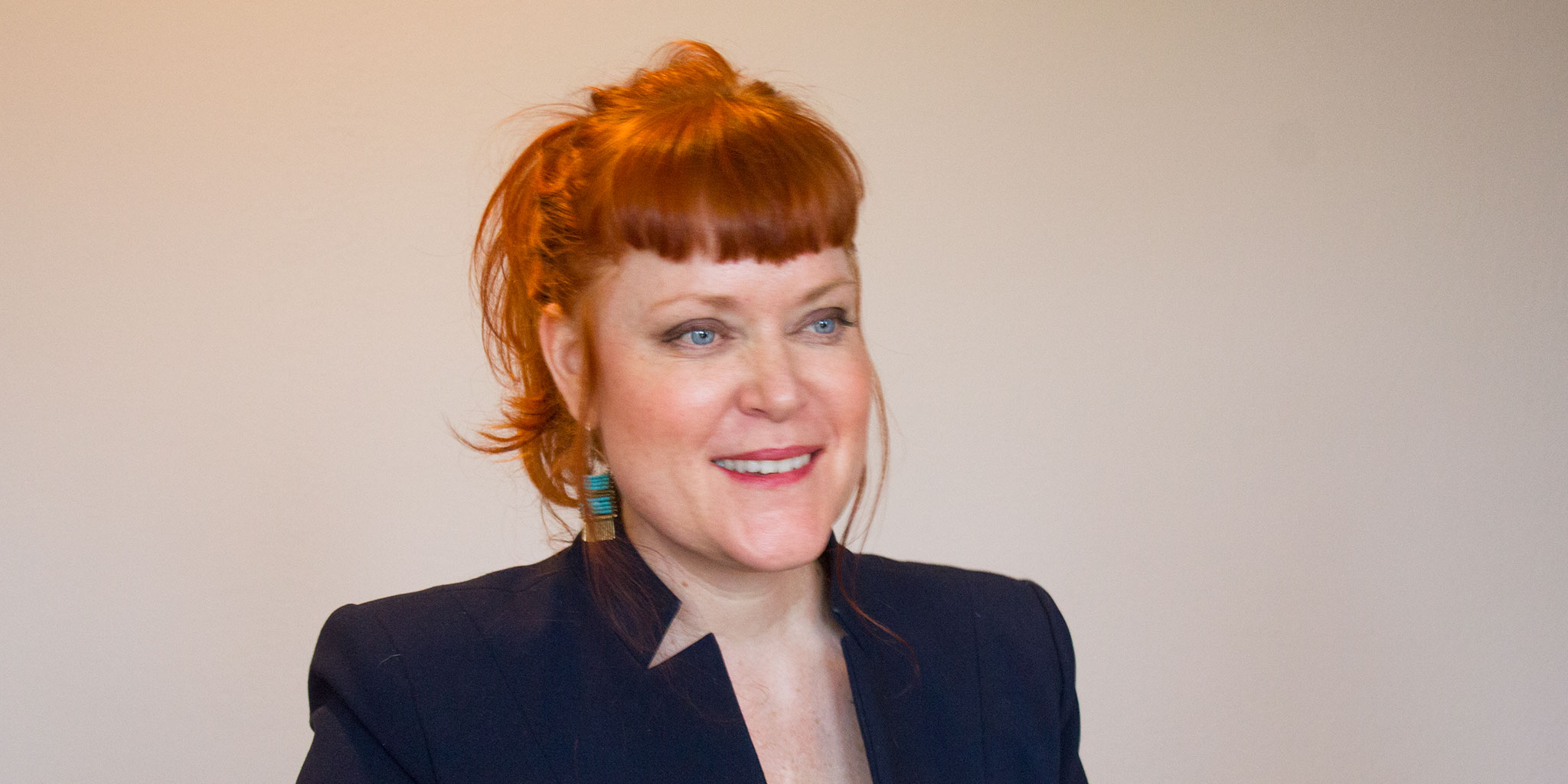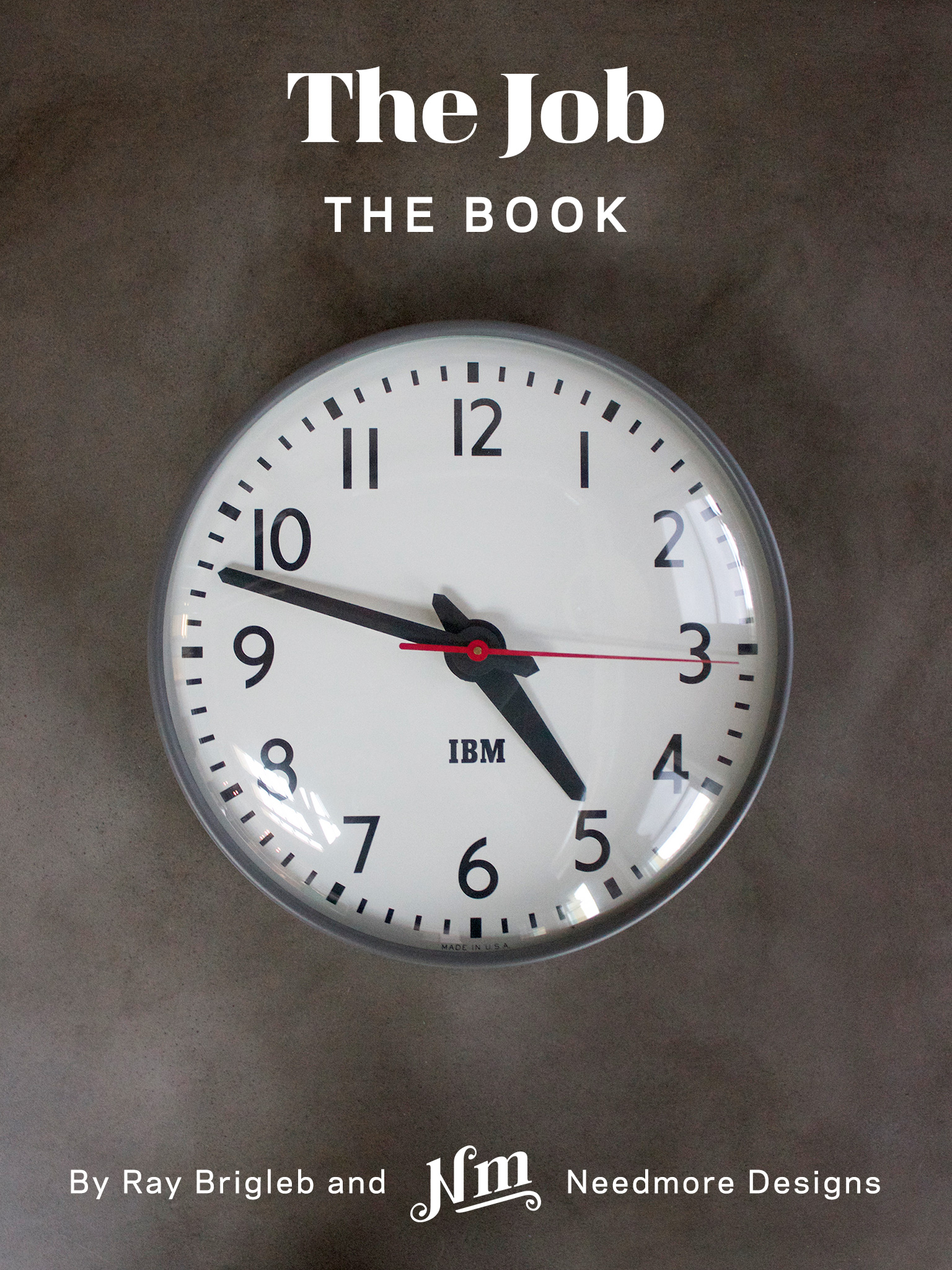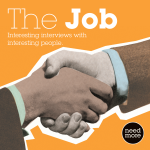
/
RSS Feed
Trish Grantham is an artist, collector, and interior designer living in Portland, Oregon.
The Interview
- Ray:
- Hi, Trish.
- Trish:
- Hey, how is it going?
- Good, good. Why don’t you tell me where you’re from?
- I was born in Phoenix, Arizona and moved to Tucson when I was in 3rd grade. Then I moved to El Paso, Texas in 6th grade and grew up there. I always consider El Paso, Texas my hometown.
- Let me turn my phone off. How long have you been in Portland and what possessed you to move to this climate after living there?
- Well, I moved to few other places. I lived in Austin, Texas and then I lived in North Chapel Hill, North Carolina. Then I went back to Austin and then I moved here 15 years ago. I had my first broken heart and wanted to get the hell out of Texas. A friend of mine said she’s moving to Portland and I said I was going to come with her. She said, “I’m leaving in a week.” I sold everything I owned and then came out here. I’d never been to the Pacific Northwest before.
- You’re known as an artist. Were you doing that before moving here?
- No.
- That was sort of a thing that came about in Portland? How’d that happen?
- I’ve lived here for just a week and I passed a art store downtown and decided to buy some art supplies.
- Really?
- Yeah.
- Which one?
- Oh gosh, what’s it called? It was the one downtown. It was the one downtown that’s not there anymore. It got bought out. Art Media.
- Yeah, I remember Art Media.
- I was like, “I’m going to buy some …” well, the boyfriend that had broken my heart was a painter. I was like, “I’ll show him,” and I did.
- Are you still in touch with this person?
- No. I mean, not like we hate each other really. It’s just things, lost touch.
- Facebook friends? Not even that?
- I don’t think so. No. I have a little beginning of that story I’d like to …
- Please do.
- It involves you. I actually did another interview this morning for a magazine called Cottages and Bungalows this morning.
- Sure, I know that lovely magazine.
- They were asking me the same story how I got started. I said that everything was timing and that I live next door to you and you decided you were going to help me make my website. I was like a, “What?”
- A website.
- I think that it all, just like everything lined up. I started art and I met you. I’d only been painting for less than a year. I was like an artist, it looked like really legit because I had a website. Nobody had a website.
- Right, the early days.
- I think that 2001.
- Was that the website with the little tear?
- Maybe, I don’t know.
- I think it was.
- I wish I had it but yeah it was like …
- I loved it. I wish I could pull that up somewhere.
- Our friend Mike had shown me some website where you can look at your past websites. It was like black background. It just had like flash.
- I think a lot of times those little website things don’t let you see the actual cool parts that were on there.
- Yeah, but it’s kind of cool it’s out there. Anyways, I just told the magazine this morning that you’ve made my website and that’s kind of how … because she was asking reference to her sister who’s an artist and how she can make it nice and it was all timing. Like I just moved to Portland.
- I don’t know that it’s that unusual for an artist to have a website now but it was back then.
- No. Yeah, it was kind of the catalyst for it all, I think.
- That was how many years ago?
- 2001 I think because you’ve just moved next door.
- Yeah, wow.
- I hadn’t met Mike yet so it was 2001, I think.
- How, and this has been such a long time, it’s a silly question perhaps but how has your art changed in that period of time?
- Well, I mean, I hadn’t gone to school and never taken art class since junior high. In fact, I was just looking at old work around your place here. I just did not use a brush. I didn’t know how to make spring colors yet. I remember at the very beginning I had no idea you could put colors together and make a new color. It was all brand. I just didn’t have the concept like if you added white to red it would make pink. I didn’t know.
- I mean, I will say, I think since we moved into the house that we are doing this interview in, I’ve seen a lot of that stuff too. I couldn’t help but think, I’ve seen a lot of your recent work. It has a lot more, I wasn’t asked but I’m going to share.
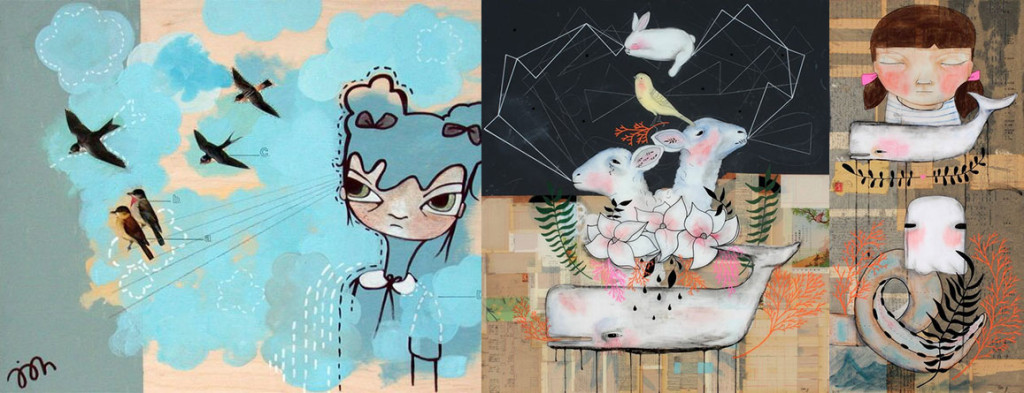
A piece of Trish’s old work on the left, and a couple newer pieces on the right.
- Go ahead.
- It has a lot more subtlety and a lot more nuance and definitely a lot more texture and depth. A lot of those early pieces seem to me like there’s solid color and sort of a drawing.
- More coloring book, more like a coloring book.
- Yeah. Have there been points that which you’ve kind of had … had there been turning points in your artwork or epiphanies where you discovered like when you discovered you can make pink or that you could layer things or you could incorporate …
- I started meeting artists and they would just give me little … there’d been certain moments that are pivotal. I went to a, like just recently, maybe I think it’s about four years ago, I went to my first art class. It was with Lisa Conden. She had this artists camp in Southern Oregon. I went. I think it was four nights or something. We just kind of gathered stuff and painted in nature. She thought me shading. That wasn’t even that long ago. My work jumped a huge step after that. It’s like all I needed was an art class.
- Well, it’s funny. Like a lot of times, there’s a lot of good that comes from classes. Like one little tip like that. It seems true in web design.
- That seems pretty high school like 101.
- Yeah, at the same time it’s like you may have learned that in high school but you weren’t … your mind wasn’t ready. You hadn’t had experience.
- Well, I didn’t take art in high school. That’s what I mean, I skipped that class.
- Well, I definitely took art in high school but I haven’t really applied any of that. Honestly, I blacked out. There’s this psychological phenomenon where something really traumatic happens. You kind of block it out of your mind. For me, art class was one of those traumatic events because they always played the radio in there extensively to make you feel more creative. Popular radio in the late ’80s was like all I can remember is endless Phil Collins and Billie Joel. I can’t be creative with Billie Joel playing. That is the worst.
- Like you needed echo and the bunny man or something.
- Yeah, I was not listening to that music at home when I was doing my creative things. Anyway, you’re also, on a personal level kind of like an avid collector. Why don’t you tell me a little bit of that, how that maybe has informed your art or not?
I don’t know. I feel like my house and my paintings match. There’s a lot of nature and animals and the colors are the same. I think it’s just like a three dimensional reflection of what I paint in a way.
- Have you always decorated like that where you’ve lived?
- I would say over the last decade yeah. I mean, I kind of have the same stuff. I just add more of it. Just like grows. The same things, there are more of them.
- Do you feel like … do you get inspiration from that? When you’re doing your art, do you surround yourself with those sort of things?
- I think I take it for granted at this point.
- It’s just background.
- Yeah, it’s just my environment.
- How do you get inspiration for your art? Is it like through music or just going out?
- It’s from old things. No, I don’t go out. I don’t leave my house. No, I mean, I think that most of my art in the recent years was all based on symbolism. I love anything symbolic. Sometimes, I’ll just start looking at religious Buddhist paintings or any sort of … I love religious icons. I love Mason icons. Heraldry, I love heraldry. Like crests and British things. I like using my characters and kind of forming them into these shields.
- Interesting. When you say Masonic imagery, you mean the six.
- Like the Masons.
- Like the pyramid, the six star of David?
- Yeah, I love that stuff.
- Interesting.
- It’s pretty subtle though.
- Do you do a lot of …
- It’s subtle. My work, it’s not like, “I’m a Mason now.”
- Right.
- I just feel like there’s always symbolic things that all different kinds of people use and I find it interesting.
- Do you do a lot of thrift shopping?
- I do for other people now because I do interior design. My style is kind of a mix of vintage and new. I mainly shop for others. I have so much stuff.
- Sure. Do you take a lot of a photos when you’re out doing that?
- Not really.
- Just to send people.
- Yeah, maybe I take a snapshot of a chair or something and send it to a client.
- When you’re putting together a show, do you do that often?
- I have one show a year now. I mean, I’m represented by a gallery here so I have one solo show there a month, I mean a year. Then almost every month they hang a piece. That’s pretty much all I show now.
- Is it like are you planning that ahead of time, like a big event or is it just you’re kind of …
- No. The show is every December, so I usually start in August. I don’t think about it prior though. I kind of don’t. I do a lot of commissions, it’s not like I’m not painting.
- You’ve also most recently done I guess the interior of the walls of Boxer Ramen.
- Right.
- Tell me how that came about and how you … how long that took to paint that whole place?
- It came about because the owner of Boxer Ramen had a friend that knew me. He wanted this artist named Yoshi Tomanara, he really wanted him to do it but his paintings are $40,000 a piece. He’s a little rough to get. She mentioned that I had a similar style. That’s kind of how that happened. It took me about three or four months.
- Wow.
- I mean, not constant.
- Sure, sure.
- I had other things going on but I just mean over the course.
- Walk me through the process. Did you sketch out what you were going to put up or you have to get your ideas, you have to run your ideas by the owner first?
Yeah, I did sketch some stuff out. He was like, “It would be great to put a big bowl of soup under this girls’ noses.” I mean, it’s just us chitchatting and evolved. I drew them out and put them over an overhead projector.
- Have you done any other pieces like that lately? I remember at one point you did a billboard.
- I did in New York. I did.
- Is that like did you project that too?
- No. I had an assistant, Michael Paulus, he’s come up a few times. I took on this job not knowing how I would paint a three-story billboard because I didn’t know how. It was for Visa and I assured them that I did know how and I had done it many times because I really wanted the job. Yeah, he came up with this whole thing because he did go to art school. I don’t even know how to explain it. I drew out the pictures and then we blew them up huge like at Kinko’s then he ran a wheel that punctured holes in all the line work. We put carbon through it up on this huge … there was just this faint little smoke line of … I kind of see but I couldn’t really see because I was only an inch or two away from the wall. It was a big project but it came out and that’s all I can …
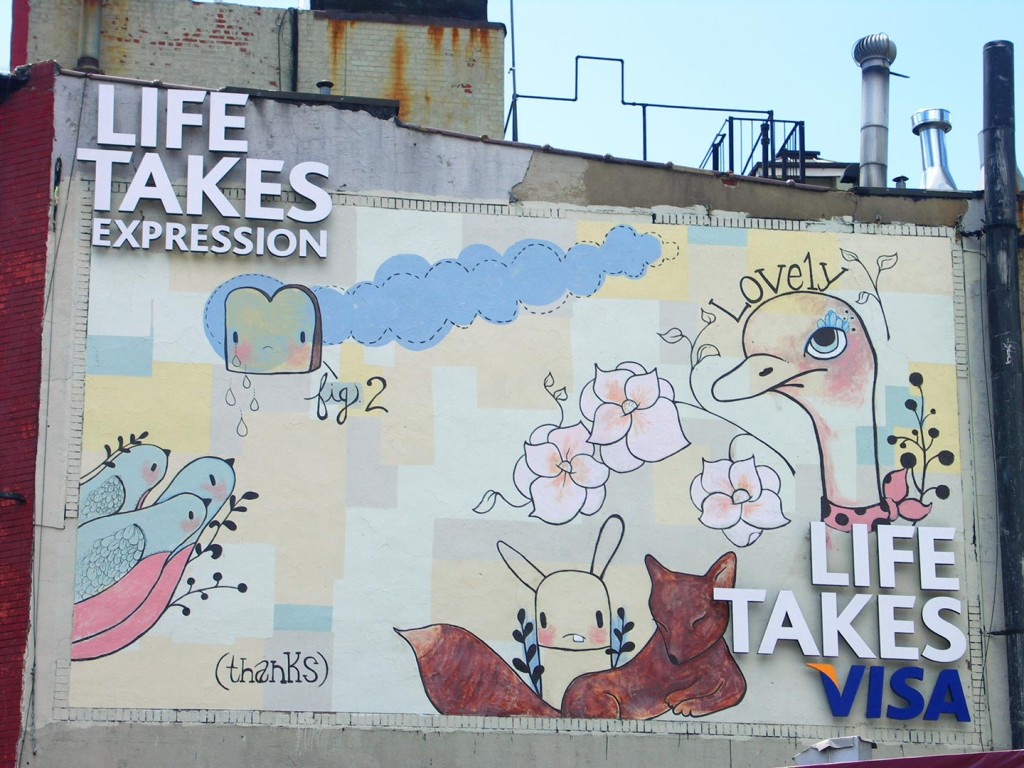
The Visa Billboard.
- Your typical art that you do, is it … what sort of media are you working with now?
- Acrylic and water color.
- Is it on a wood?
- Yeah, wood with paper glued to the top of it.
- How long does … a lot of your pieces are, I don’t know, is there a certain size?
- They’re all bigger these days. Three by four feet or so or bigger. For the gallery, I only paint really big.
- This is sort of a general question but how long does a thing like that take? Do you have any idea how many hours you put into one piece?
- I don’t. I don’t know. I mean, I work for four, five hours, take a break. I don’t know, maybe 16 hours, 25 hours, some for a bigger piece, depending on what it is.
- Do you keep good copies, like photos of them?
- I’m not as good as I should be, no. I get all the stuff shot at the gallery but the commissions, I’m horrible with. There’s a lot of commissions I have no pictures of.
- I was wondering about how does people take a good photo of art? It’s just that I’ve never been able to do it. There must be some trick.
- I don’t do it.
- Like a special broom.
- Michael Paulus does it for me.
- I’ve been trying to get him to be on the show but he won’t of course.
- Yeah, he told me he wouldn’t.
- Of course.
- He says he doesn’t do art. He’s against art. I asked him to go to a show with me next Saturday. He said, “I don’t go to art shows.”
- He doesn’t do art?
- No, he doesn’t do art. He’s throwing it out. He’s against it. Art doesn’t love him back so he’s done.
- Interesting. If someone is interested in your stuff, where would they find it online?
- I don’t really have anything for sale online anymore. You kind of just have to email me. Trish@trishgrantham.
- Trish@trishgrantham. Or they could visit trishgrantham.com?
- Yeah, I mainly just do commissions these days.
- Do you have any …
- I mean I guess I do have stuff for sale at the gallery, at the Augen, A-U-G-E-N, Augen Gallery.
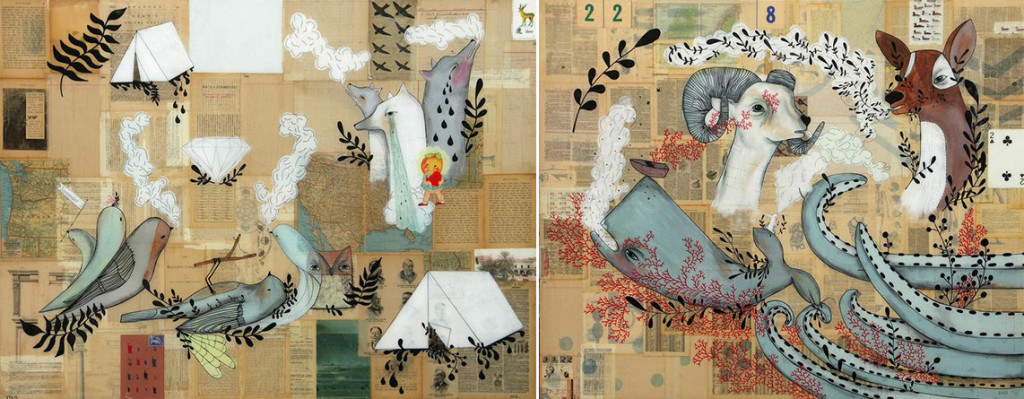
A couple gallery pieces.
- Is that in downtown? That’s not the one in the …
- It’s next to the Contemporary Craft Museum.
- Got it. That’s kind of near us, I think. We’re in Old Town. Is that kind of near Old Town?
- Yes, Broadway and Davis.
- Do you know about your little thing coming up tomorrow?
- No.
- We’re having, we’re serving espresso for first Thursday.
- Where? Oh, at your place.
- Our office. Yeah, at the White Stag.
- You’re having the first Thursday there?
- It’s like from 5 to 6:30. It’s like a pregame.
- I didn’t even know tomorrow was first Thursday.
- Are there any projects you’re working on that you can tell our listeners about?
- Well, I have a few things going on but nothing is … my house is coming out in Cottages and Bungalows in June. I think like a 5-page spread cover and all that. It will be fun. Then I don’t know. I have some works, things going on under the … like a big project that’s manifesting but I can’t talk about it.

A few spreads from Cottages and Bungalows of Trish’s home.
- I understand. You signed a nondisclosure and whatnot.
- I’m excited about it.
- Tell me this, you have been a professional artist for 13 years now.
- Ish. I mean, yeah, part of that was learning. I mean I was still waiting tables. I quit waiting tables a decade ago.
- We’ll say 10 years.
- I’ll say 10.
- Where do you see yourself in 10 more years?
- I want to just be like you know, a Pacific Northwest artist that does stuff. I don’t know. I don’t see a lot changing except for maybe I see myself becoming more iconic, I hope. I just got put in the 100 Artists of Pacific Northwest Coffee Table Book so that’s exciting.
- Nice.
- Yeah.
- Is that out now?
- It came out two days ago.
- Exciting.
- That’s kind of cool. I felt like, “Wow. I’m really a Pacific Northwesterner now.”
- That’s great. Where do you get that? Like Powell’s.
- Yeah. Or Amazon or whatever.
- Cool.
- That’s cool. No, I just want to grow old and paint and evolve.
- Have you ever considered doing like a book of your own?
- Yeah, that’s in the works with the gallery. I think I might be coming out with a coffee table book of my work which I’m having trouble with all the photographs that you mentioned earlier. Some of them are good, some of them aren’t.
- Yeah, if you ever want to shoot any of the old ones here, like retrospective.
- Yeah, that’s true.
- That’s not my phone.
- It could be mine, sorry.
- You’re on the book now. The phone’s really ringing off the hook.
- Right.
- All right. Well, Trish Grantham …
